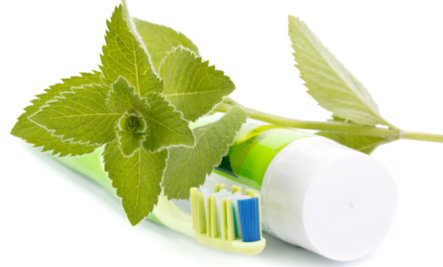Why is natural toothpaste better?

by Yuliya Klopouh, Pharm. D.
There is more to a tube of toothpaste than its benefits (tarter control, whitening, complete formula, etc.) and its flavor. If you go to your local supermarket of pharmacy, and look at the toothpaste packages, you will find shelves filled with various products. In addition to some familiar but controversial ingredients–fluoride and sodium lauryl sulfate (the ingredient that makes the paste turn foamy)–you’ll find seven main components in conventional mass-market toothpastes: detergents, abrasives, moisturizers, sweeteners, dyes, preservatives and anti-plaque substances. Most of them are easy to note since they are usually listed by long chemical names.
In contrast, natural toothpastes offer consumers products that are free of the ingredients found in their more mainstream counterparts.
Should natural toothpaste be our number one choice?
Facts to consider:
1) Fluoride or no Fluoride
There has been a long-running debate between the American Dental Association and anti-fluoride activists about whether fluoride should be routinely added to toothpastes and to the water supply. In industrial-sized quantities, fluoride is a toxic pollutant. And excessive use of fluoride in small children has been shown to discolor teeth, often permanently. To prevent this, the American Academy of Pediatrics, in the May 1995 issue of Pediatrics, suggested infants not be exposed to fluoride. But mainstream dental experts believe fluoride’s anti-cavity effects far outweigh its risks; however, many holistic dentists disagree and support natural treatments.
The most recognized problem with the ingestion of too much fluoride is dental fluorosis. This condition is characterized by the failure of tooth enamel to crystallize properly in permanent teeth. The effects range from chalky, opaque blotching of teeth to severe, rust-colored stains, surface pitting and tooth brittleness. Fluoride consumption is also believed to contribute to the incidence of hypothyroidism.
Dr. John Yiamouyiannis examined the raw data from a large study that was conducted by the National Institute for Dental Research (NIDR). He concluded that fluoride did not appear to have any decay preventing success.
A larger study has been conducted in New Zealand. The New Zealand National Health Service plan examines the teeth of every child in key age groups, and have found that the teeth of children in non-fluoridated cities were slightly better than those in the fluoridated cities.
“Foaming Effect” (Sodium Lauryl Sulfate)
“Sodium lauryl sulfate is predominantly used as a foaming agent in shampoos and mass-market toothpastes,” says Gary Verigin, DDS, a member of the Holistic Dental Association in Escalon, California. But sodium lauryl sulfate (SLS) is a skin irritant. Agents in SLS are strong enough to break down engine grease, not to mention oils in the skin. If this occurs, the skin-drying effect can lead to irritation. Ingesting SLS, an active ingredient in popular toothpastes, has been linked to a range of health problems, including eye infections and hormone imbalances. While people spit out foamy toothpaste residue, sodium lauryl sulfate can penetrate the mouth’s mucosal lining and cause cancer sores.
“Sweeteners”
Ironically, most mass-market toothpastes contain sugars, which are added for flavor but contribute to cavities. Most natural toothpastes get their fresh taste from plant extracts–such as parsley, cinnamon oil, mint and xylitol–which are healthier alternatives.
So, what are the healthy alternatives to conventional toothpastes?
1. PerioBiotic Toothpaste – PerioBiotic™ Toothpaste contains Dental-Lac™, a patent pending and clinically tested functional lactobacillus dental hygiene probiotic, not found in any other toothpaste. Research on Dental-Lac™, a specific Lactobacillus paracasei strain, demonstrates its ability to kill off harmful strains of oral bacteria including streptococcus mutans, a significant contributor to dental caries, tooth decay and periodontal disease.
Like probiotics in the human intestinal tract, beneficial flora in the mouth is critical in maintaining an oral environment conducive to healthy teeth and gums.
The ingredients not found in PerioBiotic™ Toothpaste, which are found in most other toothpastes include: fluoride, sodium lauryl sulfate (SLS), and saccharin. Also, this product is not harmful if swallowed as it does not contain fluoride.
2. Miessense Toothpaste (comes in Lemon, Mint and Anise Flavor) – Developed by European and Australian dentists, Miessense Toothpaste uses sodium bicarbonate to remove plaque and tartar. Its distinct sea salt formulation increases saliva, which helps dilute and wash away harmful bacteria. Additional ingredients include Commiphora myrrha–an aid in preventing gingivitis–and horse chestnut, an anti-inflammatory. Cleaning power is boosted with calcium carbonate and xylitol, a naturally occurring sweetener that in some research has been shown to reduce tooth decay by up to 80 percent, as well as help stop and possibly reverse the demineralization of teeth.
This toothpaste is free from synthetic fragrances, colors and preservatives.
In conclusion, natural oral care products are just as effective in removing bacteria and keeping the entire mouth healthy. Many products like peppermint and spearmint oils are naturally able to kill and prevent bacteria growth. This makes it an ideal component of natural toothpaste. We have gotten used to the minty flavor of regular toothpaste, but often there simply isn’t enough or any real peppermint in the toothpaste at all to be beneficial.
By having its origins more close to that of nature, natural toothpaste is much less likely to cause allergies or disrupt the balance of the inside of the mouth at all. Though natural toothpaste may seem somewhat different than regular toothpaste, your teeth and your body will thank you for the change.
Stay Healthy,
Dr. Yuliya Klopouh
References: (Yiamouyiannis, J.A. “Water Fluorida¬tion and Tooth Decay: Results from the 1986-87 National Survey of U.S. Schoolchildren”, Fluoride, 23, 55-67, 1990).
J Appl Microbiol. 2001 Feb;90(2):172-9. Lactic acid bacteria from healthy oral cavity of Thai volunteers: inhibition of oral pathogens.
Yuliya Klopouh, Pharm.D.
The Orpheus Clinic
Baltimore, MD
Phone: (443) 854-8673
